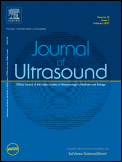
Journal of Ultrasound
Scope & Guideline
Illuminating the future of ultrasound technology.
Introduction
Aims and Scopes
- Diagnostic Imaging Techniques:
Focuses on the application of ultrasound as a primary imaging modality for diagnosing a wide range of conditions, including musculoskeletal disorders, abdominal pathologies, and vascular diseases. - Interventional Ultrasound:
Covers the use of ultrasound guidance in various minimally invasive procedures, such as biopsies, injections, and catheter placements, highlighting safety and efficacy. - Pediatric Applications:
Explores the unique applications and challenges of ultrasound in pediatric populations, including prenatal diagnostics and pediatric emergencies. - Innovative Ultrasound Technologies:
Investigates emerging ultrasound technologies, including contrast-enhanced ultrasound (CEUS), elastography, and machine learning applications, to enhance diagnostic accuracy and patient outcomes. - Point-of-Care Ultrasound (POCUS):
Emphasizes the role of ultrasound in emergency and critical care settings, demonstrating its utility in rapid diagnosis and treatment decisions. - Research Methodologies:
Utilizes both observational and experimental research designs, including systematic reviews, meta-analyses, and case studies, to strengthen the evidence base for ultrasound practices.
Trending and Emerging
- Artificial Intelligence and Machine Learning:
Increasing integration of AI and machine learning in ultrasound imaging to enhance diagnostic accuracy, automate image analysis, and assist in clinical decision-making. - Contrast-Enhanced Ultrasound (CEUS):
Growing focus on CEUS for improving diagnostic capabilities, particularly in liver, renal, and oncological assessments, demonstrating its effectiveness over traditional ultrasound methods. - Elastography Applications:
Rising interest in elastography techniques for assessing tissue stiffness in various conditions, enhancing the evaluation of liver disease, tumors, and musculoskeletal disorders. - Telemedicine and Remote Ultrasound:
Emerging research in tele-ultrasound and point-of-care ultrasound (POCUS) applications, especially in remote or underserved areas, highlighting the accessibility of ultrasound technology. - Ultrasound in Emergency and Critical Care:
Increased emphasis on ultrasound's role in emergency settings, particularly in trauma and critical care, showcasing its value in rapid diagnosis and management. - Multidisciplinary Approaches:
Collaborative studies involving ultrasound across various specialties, such as obstetrics, cardiology, and orthopedics, reflecting the growing recognition of ultrasound as a versatile diagnostic tool.
Declining or Waning
- Traditional Imaging Comparisons:
Research comparing ultrasound to older imaging modalities like X-ray and CT scans is becoming less frequent as ultrasound technology matures and is increasingly accepted as a standalone diagnostic tool. - Basic Anatomy and Physiology Studies:
There seems to be a waning interest in purely anatomical studies using ultrasound, as the focus shifts towards clinical applications and outcomes. - Static Imaging Protocols:
The trend towards dynamic and functional imaging techniques (like real-time assessments) is overshadowing static imaging protocols, which may become less relevant in the context of modern ultrasound applications.
Similar Journals
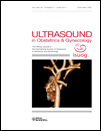
ULTRASOUND IN OBSTETRICS & GYNECOLOGY
Advancing ultrasound innovation for better reproductive health.ULTRASOUND IN OBSTETRICS & GYNECOLOGY, published by WILEY, is a premier academic journal dedicated to advancing the field of obstetrics and gynecology through innovative ultrasound research and clinical practices. With an impressive impact factor and ranking in the Q1 category across multiple medical disciplines, including Medicine (miscellaneous), Obstetrics and Gynecology, and Reproductive Medicine, this journal serves as a vital resource for healthcare professionals, researchers, and students alike. The journal's scope encompasses a wide range of topics related to ultrasound technology and its applications in reproductive health, bridging groundbreaking research with clinical excellence. Over its extensive publication history from 1991 to 2024, ULTRASOUND IN OBSTETRICS & GYNECOLOGY has established itself as a leading platform for disseminating high-quality research findings that inform practice and improve patient outcomes. Join the community of experts in exploring the latest advancements and insights in this dynamic and essential field.
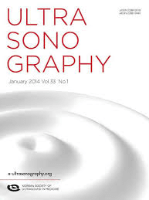
Ultrasonography
Shaping the Landscape of Ultrasound MedicineUltrasonography is a prominent open-access journal published by the Korean Society of Ultrasound Medicine, dedicated to advancing the field of medical imaging and ultrasound technology. Since its inception in 2013, the journal has provided a platform for high-quality research, review articles, and advancements in ultrasonography, filling vital knowledge gaps in the radiology, nuclear medicine, and imaging sectors. With an impressive Q2 rank in its category for 2023 and a placement in the 71st percentile according to Scopus metrics, Ultrasonography serves as a crucial resource for researchers, practitioners, and students alike. Based in South Korea, it continues to attract a global audience by offering valuable insights into the latest techniques, technologies, and applications of ultrasound in clinical practice and diagnostics. Academics can access this comprehensive journal freely, fostering greater dissemination of knowledge in the ultrasound community.
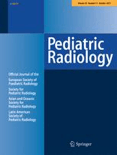
PEDIATRIC RADIOLOGY
Elevating medical imaging in child health.Pediatric Radiology is a leading journal published by Springer that provides a crucial platform for the dissemination of research in the fields of pediatrics, perinatology, and radiology. Since its inception in 1973, the journal has continually contributed to the advancement of medical imaging techniques and their application in diagnosing and treating pediatric conditions. With its impact factor reflecting a Q2 ranking in both Pediatrics and Radiology categories as of 2023, Pediatric Radiology is highly regarded in scholarly circles, aiding researchers, clinicians, and students to stay at the forefront of innovations and findings in the field. Although the journal does not offer open access, it continues to be an essential resource for evidence-based information that enhances clinical practice and improves health outcomes for children globally. The journal's reach is further established through its solid Scopus rankings, indicating its relevance and influence in the global medical community.

Medical Ultrasonography
Advancing the frontiers of ultrasound technology.Medical Ultrasonography is a premier journal dedicated to advancing the field of ultrasound medical technology. Published by the SOC ROMANA ULTRASONOGRAFE MEDICINA BIOLOGIE-SRUMB in Romania, this journal provides a vital platform for researchers, healthcare professionals, and students to disseminate high-quality research, innovative practices, and reviews in the realm of acoustics and ultrasonics, as well as radiology and ultrasound technology. With its ISSN 1844-4172 and E-ISSN 2066-8643, it has gained recognition, achieving notable rankings in Scopus across various categories - including Q2 in Acoustics and Ultrasonics and Q3 in both Radiological and Ultrasound Technology and Radiology, Nuclear Medicine and Imaging as of 2023. Operating from 2010 to 2024, the journal plays a critical role in fostering collaboration and innovation within these fields, ensuring that readers have access to the latest findings and advancements that push the boundaries of medical ultrasonography. Though it currently does not operate under an open access model, its impact and relevance within the academic community remain substantial, making it an indispensable resource for those seeking to enhance their knowledge and practice in ultrasound technology.

Emergency Radiology
Empowering Healthcare Professionals with Essential Radiology KnowledgeEmergency Radiology, published by SPRINGER HEIDELBERG, is a leading journal in the fields of emergency medicine and radiology, dedicated to advancing the understanding and application of diagnostic imaging in urgent medical conditions. Established in 1994, this journal has consistently contributed to the discourse around emergency diagnostics, maintaining a strong position within the academic community, as evidenced by its Q2 rankings in both Emergency Medicine and Radiology, Nuclear Medicine and Imaging categories as of 2023. With a distinguished focus on innovative research and case studies, it serves a diverse audience of researchers, clinicians, and healthcare professionals who seek to enhance their knowledge and improve patient outcomes in emergency settings. While the journal is not currently open access, it offers robust subscription options and continues to be an integral resource for those at the forefront of emergency care. With an ISSN of 1070-3004 and an E-ISSN of 1438-1435, Emergency Radiology is positioned to remain a key player in shaping the future of medical imaging through its commitment to high-quality research and evidence-based practices.

EUROPEAN JOURNAL OF RADIOLOGY
Advancing Imaging Excellence in HealthcareThe European Journal of Radiology, published by Elsevier Ireland Ltd, is a premier peer-reviewed journal in the fields of radiology, nuclear medicine, and imaging. Established in 1981, it has carved a significant niche within the academic community, showcasing innovative research that enhances medical imaging practices and improves patient care. With an impressive ranking in the Q1 category for both Medicine (miscellaneous) and Radiology, Nuclear Medicine, and Imaging in 2023, the journal is recognized globally for its commitment to advancing scientific knowledge and improving imaging methodologies. The journal's Scopus ranking of #60/333, placing it in the 82nd percentile, underlines its reputation for high-quality research and scholarly contributions. While traditionally a subscription-based journal, it continually evolves to meet the demands of the academic landscape, aiming to bridge the gap between research and clinical practice. Researchers, healthcare professionals, and students alike can benefit from exploring its extensive archives and current publications, which are curated to foster education and innovation in the medical imaging domain.

Cardiovascular Ultrasound
Pioneering advancements in ultrasound for better heart health.Cardiovascular Ultrasound, published by BMC, is a leading open-access journal dedicated to advancing the field of cardiovascular imaging through ultrasound techniques. Since its inception in 2003, this esteemed journal has provided a platform for high-quality research and innovative methodologies, contributing significantly to both cardiology and radiology. With an impressive impact in the academic community, it consistently ranks in the Q2 category for Cardiology and Cardiovascular Medicine, as well as in Medicine (Miscellaneous) and Radiology, Nuclear Medicine, and Imaging, as per the 2023 metrics. The journal aims to disseminate critical knowledge that enhances diagnostic practices, patient care, and clinical outcomes, making it an essential resource for researchers, clinicians, and students. Emphasizing the importance of accessible knowledge, Cardiovascular Ultrasound ensures that all published articles are freely available, fostering collaboration and innovation across the global community of cardiovascular professionals.

Journal of the Belgian Society of Radiology
Bridging Gaps in Radiology with Unrestricted AccessThe Journal of the Belgian Society of Radiology, published by UBIQUITY PRESS LTD, is a pivotal resource in the field of radiology, nuclear medicine, and imaging. With an ISSN of 2514-8281 and E-ISSN of 2514-8281, this open access journal has been dedicated to fostering the dissemination of high-quality research since its establishment in 2010. Distributed from the United Kingdom, it offers a platform for innovative studies, case reports, and reviews that contribute to the advancement of radiological sciences. Despite its current Q4 category ranking within Scopus, the journal plays a critical role in sharing essential findings with a community of over 1,200 professionals and students eager to stay abreast of emerging trends and technological advancements in imaging. By enabling unrestricted access to its publications, the journal encourages collaborative research and knowledge exchange that transcends geographic boundaries, solidifying its importance for both established researchers and emerging scholars in the discipline.
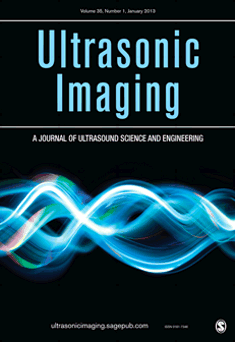
ULTRASONIC IMAGING
Pioneering the Future of Radiology and ImagingULTRASONIC IMAGING, published by SAGE PUBLICATIONS INC, is a leading journal within the fields of Radiology, Nuclear Medicine, and Imaging, with a particular focus on advancing the science and application of ultrasound technology. Since its inception in 1979, the journal has provided a platform for high-quality research, featuring innovative studies that bridge theoretical advancements and practical applications, making it an essential resource for researchers and professionals. With a notable impact factor reflecting its robust contribution to the medical community (2023: Q2 rankings in both Radiological and Ultrasound Technology and Radiology, Nuclear Medicine, and Imaging), ULTRASONIC IMAGING serves to disseminate pivotal developments in diagnostic imaging techniques, enhancing the understanding of ultrasound's role in patient care. Researchers are encouraged to explore this journal's collection of cutting-edge articles that push the boundaries of knowledge in ultrasound imaging and its implementation in clinical practices.

SKELETAL RADIOLOGY
Bridging Research and Clinical Practice in Skeletal RadiologySkeletal Radiology, published by Springer, is a preeminent journal dedicated to the field of radiology, specifically focusing on the anatomical and pathological aspects of the skeletal system. Covering a breadth of topics from imaging techniques to innovative diagnostic methodologies, it aims to enhance knowledge and expertise in the interpretation of musculoskeletal conditions. Operating under the ISSN 0364-2348 and E-ISSN 1432-2161, the journal has established itself as a key resource for researchers, clinicians, and medical professionals, boasting an impressive impact factor that reflects its scholarly significance. As of 2023, it holds a commendable ranking in the Q2 quartile for Radiology, Nuclear Medicine and Imaging, and ranks #123 out of 333 in the Scopus database, placing it in the 63rd percentile. With a history spanning from 1976 to 2024, this journal continually seeks to publish high-quality research that advances the understanding of skeletal radiology. While it does not currently offer Open Access options, its rigorous peer-review process ensures that only the most relevant and impactful studies are shared with the global academic community.